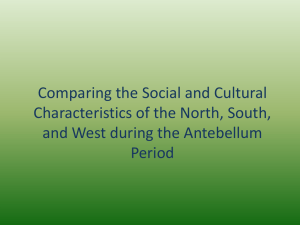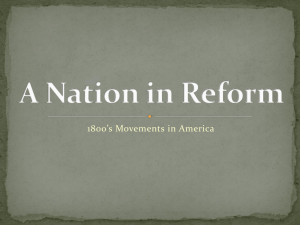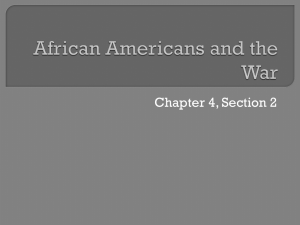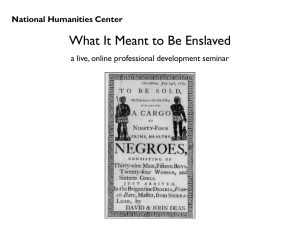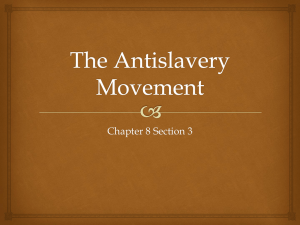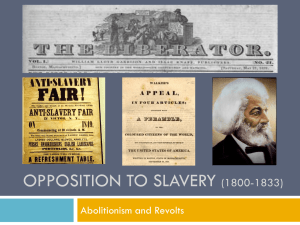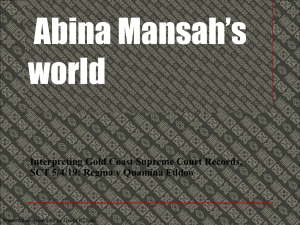Quiz time
advertisement
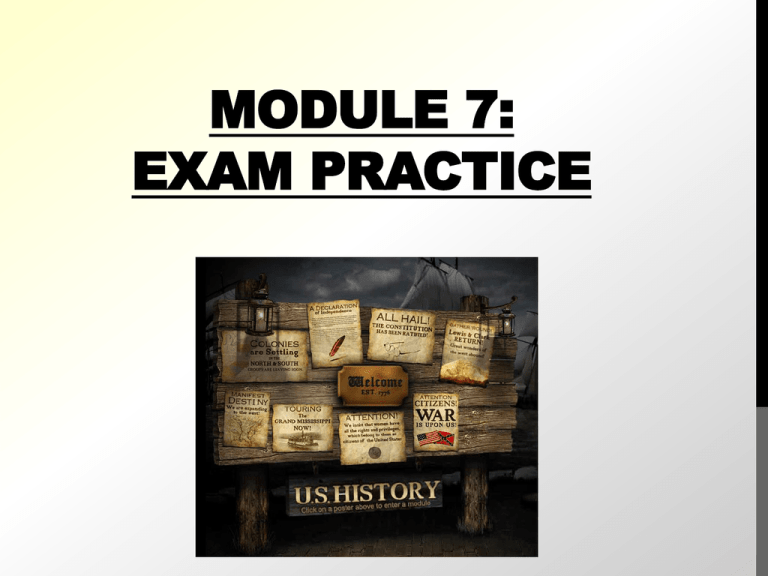
MODULE 7: EXAM PRACTICE Explore how religion, leaders of social change, and the media connected to help redefine American society. 7.01 Are You Awake? Causes (What Happened BEFORE the Second Great Awakening & Why it happened) 1. In the 1730s and 1740s, the "Great Awakening" happened mainly in New England's traditional colonial religious groups. 2. These ideas from influenced the American Revolution. 3. After the American Revolution, many people felt their churches and religious leaders needed more excitement and inspirational sermons. Courses (What Happened DURING the Second Great Awakening): Through the first half of the 1800s, religious activity peaked again The movement was more widespread and had greater long-term effects on American society Many Americans in the 1800s became evangelical Christians. Evangelicals believed humans could conquer sin and remake themselves through conversion to Christianity (or being ”born again” - a complete change of life). Participating in Camp Meetings inspired many conversions Leaders of the 2nd Great Awakening religious revival • Charles Finney • Encouraged followers to help other people confront their own sins as well; held camp meetings • Phoebe Palmer • Emphasized reflecting on one's own faith over testifying sins to others, but also believed society would improve as more people studied their faith; held prayer meetings Women participated in the Second Great Awakening more than men Consequences (What OUTCOMES Resulted Because of the Second Great Awakening): 1. Social Reform A social reform movement is a group of people working toward making a change through law to improve the community. Popular causes that arose in the 1800s were: Antislavery – abolition (ending) of slavery Temperance - outlaw the drinking of alcohol; valued discipline and productivity Women's Rights Movements – women’s right to vote Consequences (What OUTCOMES Resulted Because of the Second Great Awakening): 2. Growth of Other Religious Groups Population growth and outreach activities increased membership Some communities openly criticized the revivals and evangelical preachers, stating everyone was guilty of sin and must confront it WHICH OF THE FOLLOWING REPRESENTS A POSITIVE OUTCOME OF THE SECOND GREAT AWAKENING? [7.01] A. The government passed new laws regarding the ownership of land. B. The American people joined together to promote religious freedom for all. C. People created reform movements related to abolition and women's rights. D. The people of the North and South came together to agree to abolish slavery. IF YOU SAID C, YOU’RE CORRECT. IF YOU DID NOT, PLEASE GO BACK AND REVIEW THE CONTENT. People created reform movements related to abolition and women's rights. HOW DID RELIGIOUS CONVERSION SHOW ITSELF IN SOCIAL ACTION DURING THE SECOND GREAT AWAKENING? [7.01] A. Religious Americans thought that stricter laws would someday remove sin from society. B. Church leaders ordered their congregations to do public work as punishment for their sins. C. The converted wanted to bring more people into their church and change their communities. D. Church members wanted to follow the example of Jesus by doing good work in their communities. IF YOU SAID D, YOU’RE CORRECT. IF YOU DID NOT, PLEASE GO BACK AND REVIEW THE CONTENT. Church members wanted to follow the example of Jesus by doing good work in their communities. 7.02 Inside Slavery What was the life and culture of slaves in the mid-1800s As of 1840, there were nearly 2.5 million enslaved people in the United States, and would grow to 4 million by 1860, mostly through natural increase (growth of a population due to a greater number of births than deaths). Slave narratives were first person recollections of life under slavery Family Life About half the infants born to enslaved parents did not survive their first year of life. Adults and children alike suffered constant undernourishment. Families were torn apart or frequently under threat of separation because of the slave trade. Enslaved people had no rights under U.S. law, and so marriages were not recognized as legal. Because they did not have legal right, owners were not prevented from selling or trading in human lives. Spirituality Africans came to the United States with a variety of religious beliefs; many were polytheistic (believed in more than one God). The Second Great Awakening affected the enslaved population as well as the free as it allowed many slaves to convert to Christianity because owners felt the converting would make slaves more obedient. Enslaved people welcomed the lessons and values of Christianity, which gave hope for a life better than the one they had. Folklore also helped enslaved families teach children the values important to them, how to survive on their own, and provided entertainment when not working. Labor The largest percentage of enslaved African Americans worked on large plantations growing the cash crops of tobacco, cotton, indigo, rice, or sugarcane. The majority of people worked on farms with less than 20 slaves. They tended livestock and food crops. Some slaves had training in skills such as ironworking, tailoring, or blacksmithing, while others worked specifically as household servants, preparing and serving food, and cleaning. Homes Most slaves had houses for their own families, and houses were usually very close to each other. U.S. law did not recognize slave marriages. [True] Many slave owners used harsh punishment and reward systems to encourage hard work. [True] Most enslaved children learned basic reading and math skills. [False] Religious participation helped many enslaved people cope with their daily miseries. [True] Most enslaved people lived on large plantations. [False] Enslaved people did not nurture their children to avoid the pain of seeing them sold away. [False] Enslaved people could earn freedom by converting to Christianity. [False] Most enslaved people suffered constant undernourishment. [True] Enslaved children as young as three completed daily tasks. [True] Enslaved people lacked the ability to complete complex tasks. [False] Enslaved people had the same experience no matter where they lived. [False] Most slave owners did not allow slaves to learn to read or write. [True] What was the significance of the Second Great Awakening on slaves’ religious beliefs? A. It created more tolerance among slave owners which gave slaves their first chance to choose a religion. B. It made it illegal to punish slaves for going to religious services, so slaves could learn about the Bible without fear. C. It allowed many slaves to convert to Christianity because owners felt the converting would make slaves more obedient. D. As owners became more understanding during this movement, enslaved parents were allowed to teach their children about religion. IF YOU SAID C, YOU’RE CORRECT. IF YOU DID NOT, PLEASE GO BACK AND REVIEW THE CONTENT. It allowed many slaves to convert to Christianity because owners felt the converting would make slaves more obedient. 7.03 Join the Resistance! The Cotton Gin • Eli Whitney’s invention of the cotton gin transformed the nature of U.S. slavery in the early 1800s. • The cotton gin caused slave owners to depend even more on slavery. • The value of slaves increased, making owning slaves a large investment. • The cotton gin increased the number of slaves, and slave ownership became more profitable than ever before. • Slave owners feared financial loss and violence, like Nat Turner’s Rebellion. Laws and the Cotton Gin • Southern states passed laws to control the practice of slavery. For example, South Carolina passed a law making it illegal to emancipate (to release from slavery slaves without permission from the state). • Teaching slaves to read or write was a punishable crime in most southern states. Not all people in Northern states agreed with ending slavery or helping slaves. Active Resistance – the Anti-slavery movement Pensacola, Florida : Jonathan Walker (1799-1878) was a famous Underground Railroad “conductor.” “Conductor” was the code name for any person who helped escaped slaves. Walker was a sea captain who attempted to transport escaped slaves to the Bahamas and freedom. abolitionist Active Resistance – the Anti-slavery movement Boston, Massachusetts: William Lloyd Garrison (1805-1879) published the first edition of his Boston newspaper in 1831. Garrison wanted an immediate end to slavery. The Liberator spread his message. It featured essays by other slavery fighters, like Frederick Douglass. Print text and speeches were the main ways abolitionists spread their message. abolitionist Active Resistance – the Anti-slavery movement Baltimore, MD: Frederick Douglass (1817-1895) was born enslaved. At age 10, his master’s wife helped him learn to read, until her husband found out and stopped her. Douglass was determined to continue learning. He observed boys near his home and the shipyards where he worked. Ten years later, he disguised himself as a sailor and escaped to freedom. Douglass was a powerful speaker and was as a spokesperson for the Massachusetts Anti-Slavery Society. He published three autobiographies helping spread the message against slavery. He helped slaves escape through the New York “lines” to Canada. A “line” was the code name for an escape route on the Underground Railroad Active Resistance – the Anti-slavery movement Harriet Tubman (about 18201913) escaped enslavement in 1849. She returned 19 times to the south to help lead about 300 slaves to freedom, many from her own family. Tubman is probably the most famous conductor on the Underground Railroad. Abolitionist and conductor in the Underground Railroad Active Resistance – the Anti-slavery movement The Underground Railroad: In Newport, Ohio, about 100 people escaping slavery passed through Levi Coffin’s “station” each year for twenty years. A “station” was the code name for a safe place to hide and rest on the Underground Railroad. • Stations were often private homes or churches. Escapees were safe here from the patrollers and bloodhounds that searched for fugitive slaves. Jonathan Walker was best known for which of the following? A. Creating the first station on the Underground Railroad B. Helping slaves cross the ocean to reach the Bahamas and freedom C. Escaping slavery and then becoming a conductor on the Underground Railroad D. Fighting off crowds who wanted to destroy a printing press used for anti-slavery pamphlets IF YOU SAID B YOU’RE CORRECT. IF YOU DID NOT, PLEASE GO BACK AND REVIEW THE CONTENT. Helping slaves cross the ocean to reach the Bahamas and freedom 7.04 Her Rights In the 1800s, women could not vote and most girls did not go to school past eighth grade. U.S. society expected women to remain in the household or work in poor-paying factory jobs. Women could have meetings, publish essays, and speak in front of other women, however, they could not rise to leadership positions within reform organizations or speak to groups containing men In the 1840s and 1850s leaders of the women’s rights movement paved the way for rights women have today. The 1848 Seneca Falls Convention and writing of the Declaration of Sentiments were two critical events. Inspirations By the 1830s, many women were active in reform movements The Second Great Awakening inspired women to focus on solving social problems Many Americans believed women to be better than men at guarding morality (“morality” means to refer to some codes of conduct put forward by a society, some other group, (such as a religion) or accepted by an individual for his/her own behavior) Early Steps Women believed it was their civic duty to improve society--they were active early in the antislavery and temperance movements The antislavery movement derailed the push to win the right to vote for women. Participation in other reform movements helped strengthen the women's movement, because women's successes in them made people question the limitations placed on women in society. Society accepted women’s reform actions as long as women did not take men’s normal roles The Seneca Falls Convention in 1848 – Elizabeth Cady Stanton authorized the Declaration of Sentiments Significant Steps in the Right to Vote for Women In 1869, Susan B. Anthony and Elizabeth Cady Stanton formed the National Woman Suffrage Association (NWSA) to focus on a constitutional amendment for women’s suffrage Lucy Stone and husband Henry Blackwell formed the American Woman Suffrage Association (AWSA) to focus on passing laws at the state level Significant Steps in the Right to Vote for Women 1869, in Wyoming, Louisa Swain was the first woman to vote in the nation. Wyoming was then a territory. The movement found it easier to convince the territories to include women in voting partly because their populations were so much smaller. In 1890, the NWSA and AWSA combined to form one national organization. Women across the nation would not all be able to vote until 1920, with the passage of the 19th Amendment What derailed the push to win the right to vote for women? A. the end of the Civil War B. the anti-slavery movement C. the death of Elizabeth Cady Stanton D. the creation of the National Woman Suffrage Association IF YOU SAID B, YOU’RE CORRECT. IF YOU DID NOT, PLEASE GO BACK AND REVIEW THE CONTENT. the anti-slavery movement How did participation in other reform movements help strengthen the women's movement? A. Women's struggles in other groups made them want to have a group where they could be in charge. B. Women's success in reform movements made them question the limitations placed on them in society. C. The success of other reform programs made women think they could finally do something about women's rights. D. The experience gained working on reform programs made women qualified to create the women's rights movement. IF YOU SAID B, YOU’RE CORRECT. IF YOU DID NOT, PLEASE GO BACK AND REVIEW THE CONTENT. Women's success in reform movements made them question the limitations placed on them in society. During which of the following time periods were women most active in fulfilling their civic duty? A. B. C. D. 1776 to 1790 1790 to 1815 1800 to 1830 1840 to 1880 IF YOU SAID D, YOU’RE CORRECT. IF YOU DID NOT, PLEASE GO BACK AND REVIEW THE CONTENT. 1840 to 1880 What was one of the main driving forces behind the push for women's suffrage? A. the need to increase votes to maintain slavery in the South B. the outrage expressed by the wives of senators and other politicians C. the intense sense of civic responsibility women had during the 1800s D. the voices of former slaves like Sojourner Truth who did not follow social norms IF YOU SAID C, YOU’RE CORRECT. IF YOU DID NOT, PLEASE GO BACK AND REVIEW THE CONTENT. the intense sense of civic responsibility women had during the 1800s 7.05 Transcendentalism Transcendentalism: New England movement in literature focused on individual thought and feeling to answer questions By 1850, people could read 600 different magazines. Novels grew more popular as well. “Domestic fiction” was one type of novel. These stories featured female main characters who discovered they were stronger than they thought possible. Steam-powered presses increased the production of printed materials. Transcendentalism provides an example of the connections between historic events, protests, and literary writers. The movement developed from many events that took place in America in the 1800s, including the religious revivals of the Second Great Awakening. Some churches in the Boston area disapproved of the popular large revivals. Feelings and Emotion: Transcendentalists believed that the answers to life’s mysteries are found within us or in nature. They explored their own feelings and emotions to answer difficult questions. Some topics they wrote about were war, the mind, and social problems. They believed study and self-reflection could give better results than science. Nature: Many Transcendentalists called themselves “Christian.” Yet many believed God and nature were the same. People in New England condemned them for this and their other ideas. Their ideas were not praised, but the beauty of their nature imagery in the writers’ poetry received great attention. Nonconformity: Disapproval did not bother the Transcendentalists. They believed they had “transcended,” or gone beyond, most people in understanding the world. In their minds, conforming to, or following, what everyone else did was like losing their identity. Margaret Fuller • A supporter of women’s rights. She published her essay Woman in the Nineteenth Century in 1845. By writing, she refused to conform to what society expected of women. Henry David Thoreau He chose not to conform to American city life. He lived in the woods for two years, built a cabin, grew his own food, and studied nature. He felt that if a law went against morality, then citizens should protest it peacefully. He based his opinions on whether he thought each cause was just. Utopian Communities Groups of people tried to make Transcendentalist ideas part of daily life. They created small communities where they shared resources and chores. We call an attempt to create a perfect community a “utopia” (an ideal and perfect place for living). One example was Brook Farm in Massachusetts. It lasted only three years. Legacy: The Transcendentalists’ focus on individual thought and action helped support reform movements. They later influenced civil rights leaders like Mahatma Gandhi and the Rev. Martin Luther King Jr. who studied Thoreau’s writing. Civil disobedience featured in their efforts and helped King to understand his own struggle. 1820s and 1830s MLK Jr. 1960s Transcendentalism Quick Facts Ralph Waldo Emerson was the central person in Transcendentalism. American access to reading materials grew in the early 1800s. Domestic fiction featured females as the main characters. Transcendentalism poetry contains many references to nature. Henry David Thoreau wrote an essay about civil disobedience that inspired later reformers. A utopian community was an attempt to create a perfect place to live. Many Transcendentalists identified themselves as Christians. How did other New England Christians feel about this? A. New England Christians disagreed with the Transcendentalists because of their belief that God and nature were the same thing. B. New England Christians were upset with the Transcendentalists because of their superior attitude about Christian methodologies. C. New England Christians accepted the Transcendentalists but didn't like the negative attention they brought to their religious movement. D. New England Christians were happy to have this new group of people join their cause and express their religious ideas in new and creative ways. IF YOU SAID A, YOU’RE CORRECT. IF YOU DID NOT, PLEASE GO BACK AND REVIEW THE CONTENT. New England Christians disagreed with the Transcendentalists because of their belief that God and nature were the same thing 7.06 Bring on the Reform! In the 1800s, the antislavery and women’s rights movements gained the most attention. However, Americans also encouraged reform in a variety of other areas of life. Many reforms focused on teaching people to help themselves so they could lead better, happier lives. Children in Poverty Religious groups ran orphanages and provided other help. Yet the number of children in need kept growing, especially in cities. • Charles Loring Brace founded the Children’s Aid Society in New York City. • He wanted to help the city’s poor children. Some lived in orphanages, on the streets, or with families unable to care for them. • One of his programs was to “place out” children with families in the West who would raise them and teach them good habits. Rural families were eager for help on their farms. The children would have to help with the daily chores. • Sometimes the families valued them only for their labor. These “orphan train riders” usually were between a few months and 14 years of age. Many families adopted the children, but this was not common until after 1900. Education • In the early 1800s, there were no laws that required school attendance. • Most children worked to help support their families, either on the farm or in factory work. • Those who learned to read and write usually learned at home or through church. Wealthier families might have sent their children to small private schools. • Horace Mann was a key person in bringing education to all young Americans. He lived in Massachusetts. Thanks to Mann’s efforts, his state was the first to pass a law requiring all people under age 15 who worked in factories to attend school at least three months of the year. In 1855, the state passed a law requiring the schools to admit students no matter their “race, color, or religious opinions.” Deaf & Blind Thomas Gallaudet and Samuel Howe both helped to bring education to more of America’s youth. Gallaudet researched how to educate deaf children and helped develop American Sign Language. Howe researched blindness and helped increase the printing of materials in Braille. Their work showed Americans that people with certain disabilities were just as capable of learning complex subjects. They need the right tools and teachers. Today, laws protect people with a variety of challenges in different areas of life. For example, the Individuals with Disabilities Education Act (IDEA) says that children with disabilities must have equal access to education. Teachers with extra training, and even whole schools, exist to support students with various learning challenges. Mental Illness In the 1800s, people with mental illnesses dependent on their families. Often families could not provide enough proper care. People believed mental illness was permanent and that sufferers did not feel pain or temperature change. The mentally ill often spent many years in prisons or asylums. Sometimes the workers restrained them with chains or forced them to be alone for long periods. Dorothea Dix traveled Europe and her home state of Massachusetts to study prison conditions. Her discoveries deeply upset her, and she focused on bringing the issue to government attention. Because of Dorothea Dix, Americans began to learn that, with treatment, mental illness could improve. Her work included the founding of 32 mental hospitals and creating libraries in many hospitals and prisons. Temperance In the early 1800s, many religious groups began discouraging use of alcohol. They blamed many of society’s problems, including abuse and neglect, on alcohol. Reform leaders, especially women, called for temperance. Temperance means refraining from alcohol use. Neal Dow was a mayor in Portland, Maine. He played a crucial role in the passage of the first statewide prohibition law. Prohibition was different from temperance because it means passing laws to prevent alcohol use. From 1851 to 1856, people in Maine could be arrested for making or selling alcohol. Some Americans who refrain from alcohol call themselves “teetotalers,” a term that began in the 1830s. Where would a mentally ill patient in the 1800s most likely be found? A. in group homes run by religious groups and supported by public donations. B. on the streets or in homeless shelters, usually unaware of their surroundings. C. in prisons or asylums, often restrained with chains or in solitary confinement. D. with their families at home, most often confined to a basement or single room IF YOU SAID C YOU’RE CORRECT. IF YOU DID NOT, PLEASE GO BACK AND REVIEW THE CONTENT. in prisons or asylums, often restrained with chains or in solitary confinement If Neal Dow were alive today, he would be interested in which of the following? A. new laws regarding current educational standards. B. programs related to substance abuse prevention. C. programs to help families and children living in poverty. D. new methods being used by doctors to treat mental illness. IF YOU SAID B YOU’RE CORRECT. IF YOU DID NOT, PLEASE GO BACK AND REVIEW THE CONTENT. programs related to substance abuse prevention. Play the Module 7 Review Game: http://www.quia.com/rr/806551.html Take your module 7 exam. Your goal is to score a 60% or higher. We know you can do it!
